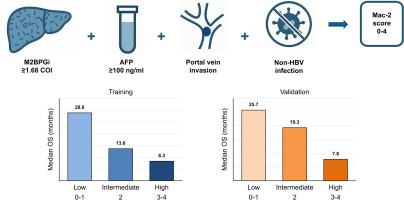基于血清纤维化标志物m2bpgi的新评分预测接受免疫治疗的不可切除HCC的生存
IF 7.5
1区 医学
Q1 GASTROENTEROLOGY & HEPATOLOGY
引用次数: 0
摘要
背景,目的大多数肝细胞癌(HCC)患者有潜在的慢性肝病,这可能影响生存结果。Mac-2结合蛋白糖基化异构体(M2BPGi)是反映肝纤维化状态的生物标志物,这反过来可能与接受免疫检查点抑制剂(ICIs)治疗的HCC患者的生存有关,特别是在病毒性肝炎流行的地区。方法2017年9月至2022年9月,前瞻性纳入158例接受ICIs治疗不可切除HCC的患者,收集基线血清样本进行M2BPGi测量。分析与总生存期(OS)相关的变量。在2022年10月之后,另外连续招募了60名不可切除的HCC患者进行验证。结果在训练队列中,血清M2BPGi水平与纤维化-4评分、Child-Pugh分级及ALBI(白蛋白-胆红素)分级密切相关。M2BPGi≥1.68 COI(截止指数)与OS显著降低相关(风险比1.992,95% CI 1.369-2.900;p & lt; 0.001)。通过结合基线甲胎蛋白(≥100 ng/ml)、M2BPGi(≥1.68 COI)、门静脉侵犯和非hbv感染,建立了一个新的Mac-2评分,有效地按OS对患者进行分层(0-1、2和3-4评分分别为28.8、13.6和8.3个月,p <0.001)。与CRAFITY评分、ALBI分级和Child-Pugh分级相比,Mac-2评分表现出更强的辨别和校准能力(AUROC最高,同质性最强,赤池信息标准校正值最低),并有净重分类改善。结论血清纤维化标志物M2BPGi与肝细胞癌免疫治疗患者肝储备及生存相关。新开发的Mac-2评分可能在这一人群中提供更好的临床效用。影响和意义大多数肝细胞癌发生在伴有肝纤维化或肝硬化的患者中,纤维化微环境可能影响免疫检查点抑制剂的抗肿瘤作用。血清M2BPGi反映肝细胞癌的肝纤维化状态和肝储备,并与接受基于ci的免疫治疗的患者的生存结果相关。基于基线M2BPGi水平的新型Mac-2评分有可能增强患者选择和指导治疗策略。本文章由计算机程序翻译,如有差异,请以英文原文为准。

Serum fibrosis marker M2BPGi-based novel score predicts survival of unresectable HCC undergoing immunotherapy
Background & Aims
Most patients with hepatocellular carcinoma (HCC) have underlying chronic liver disease, which may influence survival outcomes. Mac-2 binding protein glycosylation isomer (M2BPGi) is a biomarker reflecting liver fibrosis status, which in turn may be associated with survival in patients with HCC treated with immune checkpoint inhibitors (ICIs), particularly in regions where viral hepatitis is endemic.
Methods
From September 2017 to September 2022, 158 patients receiving ICIs for unresectable HCC were prospectively enrolled, and baseline serum samples were collected for M2BPGi measurement. Variables associated with overall survival (OS) were analyzed. An additional 60 consecutive patients with unresectable HCC were recruited after October 2022 for validation.
Results
In the training cohort, serum M2BPGi level correlated strongly with Fibrosis-4 score, Child-Pugh class and ALBI (albumin-bilirubin) grade. An M2BPGi ≥1.68 COI (cut-off index) was associated with significantly reduced OS (hazard ratio 1.992, 95% CI 1.369–2.900; p <0.001). By incorporating baseline alpha-fetoprotein (≥100 ng/ml), M2BPGi (≥1.68 COI), portal vein invasion, and non-HBV infection, a new Mac-2 score was developed that effectively stratified patients by OS (28.8, 13.6 and 8.3 months for scores of 0-1, 2 and 3-4, respectively, p <0.001). The Mac-2 score demonstrated superior discrimination and calibration abilities (the highest AUROC, greatest homogeneity, and the lowest corrected Akaike information criterion value), and net reclassification improvement compared with the CRAFITY score, ALBI grade, and Child-Pugh class.
Conclusion
Serum fibrosis marker M2BPGi correlates with liver reserves and survival in patients with HCC undergoing ICI-based immunotherapy. The newly developed Mac-2 score may offer improved clinical utility in this population.
Impact and implications
Most cases of hepatocellular carcinoma occur in patients with underlying liver fibrosis or cirrhosis, and the fibrotic microenvironment may influence the anti-tumor effects of immune checkpoint inhibitors. Serum M2BPGi reflects liver fibrosis status and liver reserve in hepatocellular carcinoma and is associated with survival outcomes in patients receiving ICI-based immunotherapy. The novel Mac-2 score, based on baseline M2BPGi levels, has the potential to enhance patient selection and guide therapeutic strategies.
求助全文
通过发布文献求助,成功后即可免费获取论文全文。
去求助
来源期刊

JHEP Reports
GASTROENTEROLOGY & HEPATOLOGY-
CiteScore
12.40
自引率
2.40%
发文量
161
审稿时长
36 days
期刊介绍:
JHEP Reports is an open access journal that is affiliated with the European Association for the Study of the Liver (EASL). It serves as a companion journal to the highly respected Journal of Hepatology.
The primary objective of JHEP Reports is to publish original papers and reviews that contribute to the advancement of knowledge in the field of liver diseases. The journal covers a wide range of topics, including basic, translational, and clinical research. It also focuses on global issues in hepatology, with particular emphasis on areas such as clinical trials, novel diagnostics, precision medicine and therapeutics, cancer research, cellular and molecular studies, artificial intelligence, microbiome research, epidemiology, and cutting-edge technologies.
In summary, JHEP Reports is dedicated to promoting scientific discoveries and innovations in liver diseases through the publication of high-quality research papers and reviews covering various aspects of hepatology.
 求助内容:
求助内容: 应助结果提醒方式:
应助结果提醒方式:


